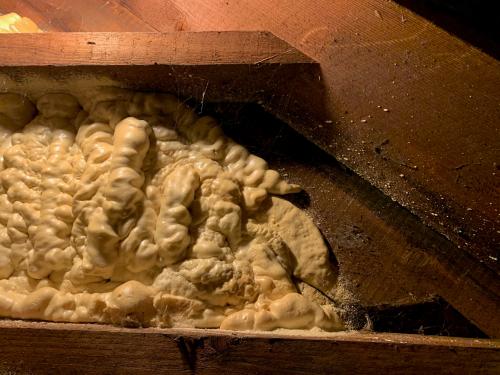What is Spray Insulation Made of?

Spray foam insulation is a two-component product that is mixed during the application process. Isocyanate (the A component) and resin (the B) are funneled through two heated hoses and join up at the tip of a foam spray gun.
This forms expanding foam insulation that is applied into wall cavities on commercial roofs, roof tiles (and many other places). Foam can also be installed into homes and building through exterior walls by drilling holes into the sheathing cavity of a finished wall or concrete block or brick siding and is commonly referred to as injection foam or wall foam injection.
Spray foam is generally used in new home construction as the walls and attic need to be exposed. Since this product expands swiftly, this general sort of foam material is not a good candidate for injecting into walls. The injection foam is a slow-rise formula (chemical makeup) and is used primarily used for renovation projects when the plaster or drywall is already attached.
What is the Difference Between Open Closed Cell Foam?
In general, people think “R-Value” and a higher number translates into the product being better insulation.
There are actually many things to consider when formulating an opinion on this topic.
The things to consider when discussing R-Value of Insulation…
How well does the insulation stop air leakage all around the structure?
How well does the spray foam insulation reduce air drafts around the hard-to-reach places such as electrical wiring, plumbing to/from the building?
How well will your insulation work after a building structure shifts or moves in time?
What happens if your insulation gets wet or retains moisture?
Does the insulation control or block sound well?
Is Spray Foam Safe to Use?
There are several precautions to take when installing spray polyurethane foam in your home or building.
If you are considering spray foam or any insulation product you should learn all you can before making the decision that’s right for you.
Is Spray Foam Safe to Use?
There are several precautions to take when installing spray polyurethane foam in your home or building.
If you are considering spray foam or any insulation product you should learn all you can before making the decision that’s right for you.
This website does not endorse, guarantee, or warranty that the contractor will apply the product as the manufacturer requires them to do.
The best information we can offer to you as we are only an information website, not a contractor, is to ask for the specifications from the foam manufacturer, get as much information you can get on your own (or through industry organizations such as the Spray Foam Alliance.
Most of this information has been cited on Wikipedia or you can find it on the web yourself.
Facts
that may be found in vapors, aerosols, dust, or on surfaces during and for a period of time after spray foam installation may cause adverse health effects such as asthma. Therefore, steps to control exposures and safety tips should be followed.”
Chemicals in SPF Products
SPF products contain approximately 50 percent Side A and 50 percent Side B. This chemical reaction generates heat.
(Industry is supporting the development of a standard method for measuring off-gassing of volatile chemicals.)
Isocyanate Compounds Commonly Used in SPF and related products
Isocyanates are chemical substances containing an isocyanate (-N=C=O) functional group. Diisocyanates have two isocyanate functional groups. Other isocyanates contain several isocyanate groups.
Isocyanates have a broad range of uses in the manufacture of consumer products, including:
Spray foam
Coatings, e.g., paints and varnishes
Caulks, glues, adhesives
Elastomers
Fibers
Flexible and rigid foams (used in mattresses, pillows, furniture, automotive seats, insulation, and roofing)
Flexible and rigid foams (used in mattresses, pillows, furniture, automotive seats, insulation, and roofing)
Spray applications of isocyanates may generate aerosols, mist, and vapors that can be inhaled or come in contact with the eyes or skin. Potential exposures may occur through skin contact or inhalation of particulates and dust particles containing isocyanates.
Most of the information as published is cited from the United States EPA website. You can read all about it here.
Post Your Ad Here
Comments